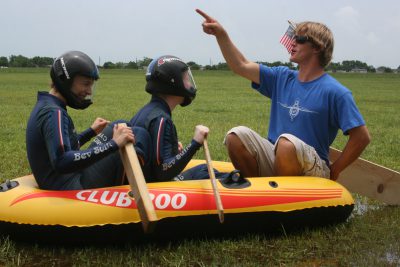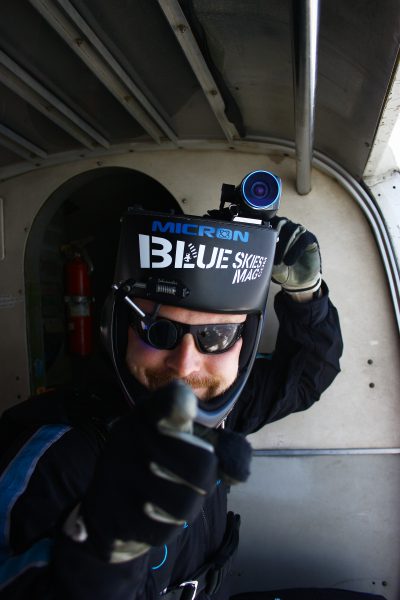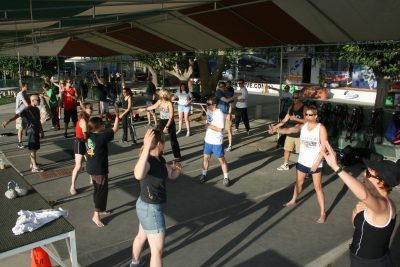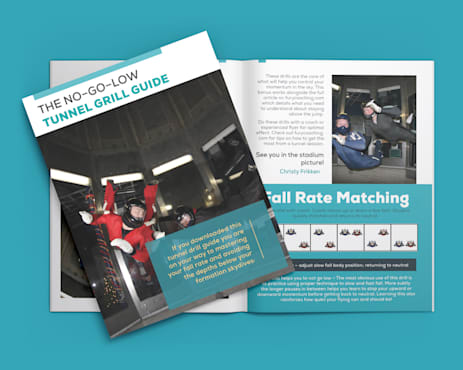The complete guide to setting up your team’s season
Monday, February 1, 2021

Teams break up mid-season when they discover each of the members had different visions for the year. After you have defined in broader strokes what a great season will look like, it is time to clarify details with this useful guide and downloadable Team Season Agreement.
Critical discussions
Budget, schedule, tunnel, jumps, video, coaching, packing, and competitions are all factors you’ll need to agree on with your team. Teams can fail when members gloss over each other’s constraints, so listen and respect your prospective teammates’ limits.
There is a lot in this guide and a lot in the season contract. Here are the biggest pitfalls. Go through these first: Budget, jumps and tunnel proportions, and missing camp responsibilities. After that, you can use the season agreement to dig into smaller details as desired.
Budget first
My best piece of advice for teams, especially inexperienced teams, is to define their constraints with a budget as opposed to jump numbers. Two people who want 200 jumps might still wish for very different things.
| Person A means 200 jumps plus 20 hours tunnel with video, packing, coaching, back-to-backs, nationals, and extra days for weather. | Person B means 200 jumps maximum without tunnel on 40-minute calls using GoPro video and without any competitions.
|
Neither is wrong. These prospective teammates just need to align their visions more precisely.
Define what you can spend in dollars. If all party members do this, the methods become negotiation points and provide flexibility. You can debate switching out a tunnel camp or getting a coach without worrying about hitting people’s constraints.
Time and scheduling are constraints, too, but adding dates to a calendar is usually concrete enough to avoid mishaps.
Jumps and tunnel
Once you have a budget, you should decide about how many skydives and how much tunnel you aim to do. How many jumps? Back-to-backs? How much tunnel? Coaching? Since you have your significant restrictions in place, now you can adjust the sliders to reach the perfect situation.
Missing camps
Life happens! Work or personal situations arise that translate into missed camps. Decide now how the group will commit to dealing with this to avoid stress and grievances later.
The crux of the planning will be whether you cancel or use fill-ins and deciding who covers additional financial obligations.
Don’t skip this step before you start your season in earnest.
The agreement
The team season contract is a list of talking points. Run through it with your team before committing so you are all planning on the same thing! Even if you don’t hammer out every detail, a friendly group discussion over beer is a great start.
Goals
Discuss your individual goals and develop a set of team goals. It is okay to have an outcome goal or two (winning intermediate, fifteen-point average), but flesh it out with process and performance goals (compete as well as you train, improve focus, know the blocks from every slot, learn slot-switchers).
Attitude
Talk about how you want to train. Discuss how you want to treat each other and others around the dropzone. Consider how you will handle disagreements and stress. These goals are often overlooked but make the difference between a terrible and a fantastic experience.
Budget
How much per camp, month, or season will you budget? Talk about what that must encompass—jumps, tunnel, coaching, packing, travel, meet fees, etc.
Do your prep work for this stage; call around and ask about various fees from multiple sources. You may even start negotiating at this stage. Dropzones offer team rates, tunnels provide bulk discounts, and coaches are worth every penny. (We negotiate extra days, competition discounts, etc.)
Changing the budget
Discuss options if you run over budget (if tunnel time or jump prices increase, for example). Either agree to a hard maximum or allow the team to reconsider and vote.
Flexible or rigid
Consider whether you will allow excess money from one month to roll over to an upcoming month. For example, if there is bad weather, will you allow extra tunnel the next month or stick to each month’s allotment?
Competitions
Many teams have a final meet, like the Nationals here in the US, as their season-defining event. Meets are not a requirement (I frequently coach non-competition-oriented groups). Clarify your competition plan now!
Time and schedule
The second significant restriction is the amount of time available. Get creative and define how much time each of you can realistically spend. Block off any dates you know will not work. Consider your vacation time. Think about what you could do at the local tunnel on weekday evenings.
Tip: The earlier you set your schedule in the season, the easier it will be for teammates to work around. You’ll also have better access to your preferred coach, video flyer, packer, and tunnel times.
Changing the schedule
Judging from the busy people I coach, once a plan is locked in, it is difficult to change. Nonetheless, it is worth discussing how to make a change if necessary.
Tunnel
Most teams choose to do a good chunk of tunnel for its cost-effectiveness and year-round availability. Looking at your budget, decide what percentage you will allocate. You’ll have to factor in what tunnels you might use, what travel cost might be involved, what the going rates are, and weekend availability.
Decide if you are doing whole-day camps or evening meetups. For an entire day, most teams will do between 45 to 75 minutes a day, split into 15-minute chunks with breaks between 30 and 60 minutes in between. If you are creeping a lot, not used to the tunnel, or considering tunnel rigs, plan for less.
Jumping
If you are lucky to have a supportive dropzone that can accommodate your training locally, hooray! Many teams or teammates will have to consider a variety of dropzones. Consider climate, planes, rates, tunnels, coaches, and ease of travel. Cheap prices are not a good deal if they leave your group sitting in the rain drinking beer, wondering when the Cessna will be fixed.
Calculate the number of days you will spend jumping by looking at your schedule restraints or working backward from the target number of season jumps. If you can do only 15 days for the season, then that is the starting place. If you are dead set on squeezing in 300 jumps, do the math to see how much time is required.
Talk with your group—you will need to know how many jumps you can realistically make in a day. There are a lot of factors that work into this, including pace, back-to-backs, climate, dropzone availability, experience level, and outright fitness. If you are unsure, ask someone who has trained at your target DZ what they achieved.
Remember, your target number might not be your average. If you are aiming for 12 jumps a day and stop at 12 no matter what, you will average much less when you account for weather or competition prep. It varies based on your local climate, but I expect the real jump numbers will be 80% of the target.
Teammates missing days
It is troublesome when someone has to cancel a camp, especially at the last minute. The team needs to decide in advance how to handle this to avoid fights down the road.
Alternate plan
First, a fill-in will have to be a couple of points better than the team if the team is not to suffer a performance hit. If you are newer, that isn’t such a big deal, because you will have more alternate options in your scoring range. A 14-point-average team, however, might struggle to find a 16-point flyer available and interested.
Timing matters. If you know months in advance that you can’t make it, you have a better chance of finding someone suitable to fill in. Two days’ notice might not be as successful.
Non-refundable expenses. If people on your team travel in, they may have already purchased tickets and accommodation. If you booked a coach, they will likely expect payment if you cancel without adequate lead time.
Short term vs. long term. If someone has a work meeting that’s come up unexpectedly, you need a fill-in. If someone loses their job and can’t continue, you will need another course of action.
Money
Now for the big question—who pays? If you need a coach to fill in for a last-minute situation, is the missing party responsible? For slots, video, coaching fees, and packing? Under what circumstances? Have this conversation now to avoid a big fight later.
More serious groups will expect the missing person to cover expenses for an appropriate fill-in. This fulfills the obligation to the other teammates who were counting on that camp. If there is a cheaper suitable option, the team will take it to reduce the missing teammate’s burden.
Relaxed or local groups might be okay with a less-than-perfect fill-in or canceling. If there aren’t any losses experienced, then no one is shorted.
Coaching
There are smart reasons to work with a formation skydiving coach. You’ll want to consider whether you’re going to work with someone locally, travel to a coach, have them come to you, or work with them remotely.
You can elect to work with someone for every training day or just a few camps. If you are choosing a part-time coach, I strongly favor having them with you in the tunnel because of the large amount of flying. Tunnel coaching will set up a stronger foundation and keep you from practicing mistakes until they become muscle memory.
Related: Choosing a Great Coach
Using multiple coaches is an option, just not too many. My first real trained team, AZ Audacity, had this great idea to use a different person for every single camp. It ended up being ineffective because each coach showed us a different technique and a different set of focal points. Instead of gathering great new ideas from each professional, we ended up confused and disjointed.
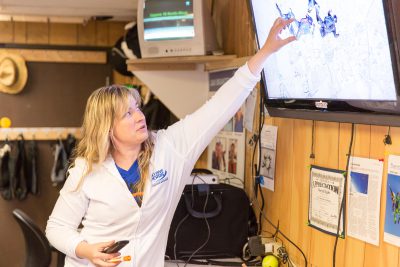
Video
Just because someone has a GoPro doesn’t mean they are a skilled video flyer. Video flyers‘ roles and costs vary regionally. However, you can expect to pay more for more experienced videographers who rarely miss an exit.
If you are newer and launching only one or two exits, think about a video person who is also learning. If they are brand new, you could start by having them cover their jump expenses as they practice and move towards paying their slot as they reach certain milestones through the season.
If you are using a coach or keying quickly on the hill, you might want to hire someone with a larger skillset to have a quality video right away and through any competitions. It is more expensive, but it can be pleasant not to stress about finding the fifth teammate.
Packing
Packing sucks energy and time. Most teams elect to use a packing team while they train. It allows them to focus more intently on prep, debrief, and jumping. Packers make back-to-backs possible.
On the flip side, packing reduces the budget, and some people prefer controlling their gear. It is tough, but not impossible, to do 12 jumps a day and pack yourself. If cash is your concern, you might consider packing yourself on longer breaks and at the end of the day as a compromise.
Weather plan
For a surprisingly complete guide to weather plans, I wrote an article.
The short version is to decide in advance who will call it and for what reasons on the day when the weather hits and whether you will try to reschedule if you lose jumps. Skydiving is a “must be present to win” sport; be very careful about canceling before you show up to the DZ.
Rotating captain
Now is an excellent time to decide how to decide stuff! I wholeheartedly recommend a rotating captainship.
Talk about how to choose a meet time, how to make weather decisions, who comes up with the dive plan, and how you will stick to the prep plan. You can also consider now who might be in charge of the money matters, communicating with the DZ, coach, videographer, and packers, and other obligations.
Homework
Want to become much better quickly at no cost? Easy! Do your homework. Determine what amount of visualizing, video watching, and planning is the right amount. Make mechanisms and accountability plans to support your promises.
Final exercise
Before you close out, talk through a perfect training day together. What time did you meet? How did the morning go? Did you stretch as a group or jump right to prep? How fast did you go? How long did the day last? How was the closeout?
Talk through everything that might come up in a typical day and craft an exciting vision of a camp. It will encompass a lot of the contract points above, but you might catch a discrepancy or gather a fantastic idea!
Are you exhausted from all that talking? Better a long breakfast at the Perris Bombshelter now than a blow-up later. Grab the agreement template to help yourself along! Contact Christy for more guidance in setting up your team.
Related
The First Critical Step for Finding a Great Team
What to do when it all goes wrong mid-season


